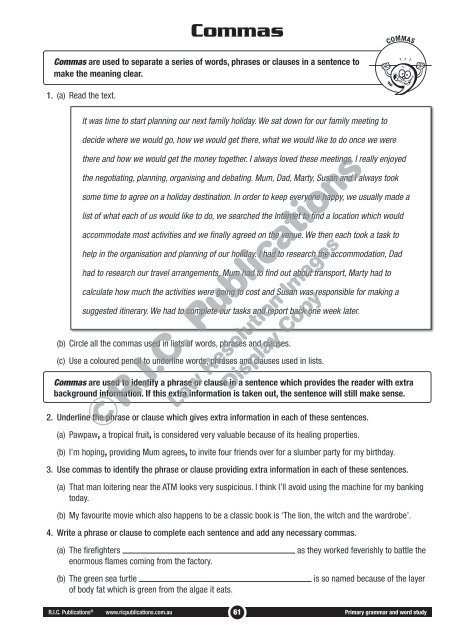RIC-20248 Primary Grammar and Word Study Year 6 – Punctuation
Create successful ePaper yourself
Turn your PDF publications into a flip-book with our unique Google optimized e-Paper software.
Commas<br />
Commas are used to separate a series of words, phrases or clauses in a sentence to<br />
make the meaning clear.<br />
1. (a) Read the text.<br />
It was time to start planning our next family holiday. We sat down for our family meeting to<br />
decide where we would go, how we would get there, what we would like to do once we were<br />
there <strong>and</strong> how we would get the money together. I always loved these meetings. I really enjoyed<br />
the negotiating, planning, organising <strong>and</strong> debating. Mum, Dad, Marty, Susan <strong>and</strong> I always took<br />
some time to agree on a holiday destination. In order to keep everyone happy, we usually made a<br />
list of what each of us would like to do, we searched the Internet to find a location which would<br />
accommodate most activities <strong>and</strong> we finally agreed on the venue. We then each took a task to<br />
help in the organisation <strong>and</strong> planning of our holiday. I had to research the accommodation, Dad<br />
had to research our travel arrangements, Mum had to find out about transport, Marty had to<br />
calculate how much the activities were going to cost <strong>and</strong> Susan was responsible for making a<br />
suggested itinerary. We had to complete our tasks <strong>and</strong> report back one week later.<br />
(b) Circle all the commas used in lists of words, phrases <strong>and</strong> clauses.<br />
(c) Use a coloured pencil to underline words, phrases <strong>and</strong> clauses used in lists.<br />
Commas are used to identify a phrase or clause in a sentence which provides the reader with extra<br />
background information. If this extra information is taken out, the sentence will still make sense.<br />
©R.I.C. Publications<br />
Low Resolution Images<br />
Display Copy<br />
2. Underline the phrase or clause which gives extra information in each of these sentences.<br />
(a) Pawpaw, a tropical fruit, is considered very valuable because of its healing properties.<br />
(b) I’m hoping, providing Mum agrees, to invite four friends over for a slumber party for my birthday.<br />
3. Use commas to identify the phrase or clause providing extra information in each of these sentences.<br />
(a) That man loitering near the ATM looks very suspicious. I think I’ll avoid using the machine for my banking<br />
today.<br />
(b) My favourite movie which also happens to be a classic book is ‘The lion, the witch <strong>and</strong> the wardrobe’.<br />
4. Write a phrase or clause to complete each sentence <strong>and</strong> add any necessary commas.<br />
(a) The firefighters<br />
enormous flames coming from the factory.<br />
(b) The green sea turtle<br />
of body fat which is green from the algae it eats.<br />
as they worked feverishly to battle the<br />
is so named because of the layer<br />
R.I.C. Publications ® www.ricpublications.com.au 61<br />
<strong>Primary</strong> grammar <strong>and</strong> word study


















